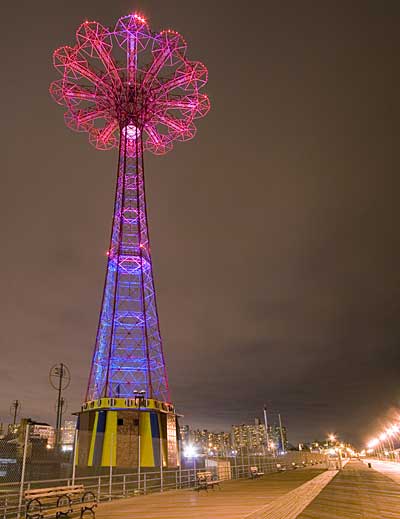Parachute Jump Gets Lighter

If the Parachute Jump, the famed thrill ride that operated at Coney Island between 1941 and 1964, was once compared to a flower, the 277-foot structure had become a spent dandelion by the late ’90s—so much so that planners of a new minor league baseball stadium feared the Jump might topple onto it. In July, the Brooklyn icon bloomed once again, with the launch of a new integral lighting installation designed by Leni Schwendinger Light Projects.
For Schwendinger, lighting designs explore “what’s possible with light above and beyond safety and security.” She adds, “What’s interesting about this way of working with light and lighting in the urban context is that we’re able to give these iconic figures a kind of fluidity or flexibility about them.”
Her transformation of the Jump is a delightful addition to the area’s nighttime landscape, one that connects the gritty edge of Brooklyn with the rhythms of nature: One light sequence, for example, accompanies the full moon’s arrival and departure with a three-day waxing and waning of whites.
Although the illuminated Jump is being celebrated as a symbol of Coney Island’s rebirth, the gestation of the project goes as far back as 1999, when New York Department of Design and Construction enlisted architectural engineering firm STV to preserve the structure. The firm ultimately chose to take apart the rusted and delaminated tower in sections so that contractors could replace steel components and remove lead paint without contaminating the beach area, then reassembled it with new high-strength bolts securing the splice plates against the wind. After work was completed in 2003, “there was a little lull in the action,” says Albert Thompson, STV’s project manager. “The city realized that it had received a newly refurbished, bright, shiny tower, [but] it could only be appreciated during the daytime.”
A year later a consortium of city organizations revisited STV’s early suggestion that the Jump be transformed into a lighted, public artwork. Officials were particularly keen on the project because they felt the area was ripe for economic development. “The focus was not only on the Parachute Jump,” Thompson explains, “there was a focus on revitalizing Coney Island.”
Schwendinger was chosen from a shortlist of four teams to compose the lighting design. In her scheme, 17 floodlights and 450 LEDs perform five variations besides the moon dance, including compositions for weekdays, weekends, and special events, which keep repeat customers enthralled. Schwendinger says, “I like to connect with the actual activities, the meaning of the site, the uses of the site, and express those in new ways.”


0 Comments:
Post a Comment
<< Home